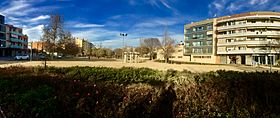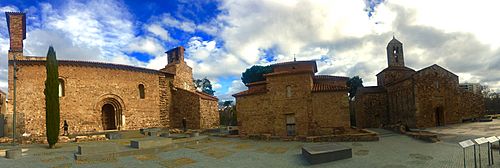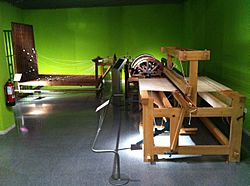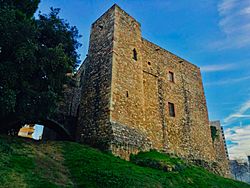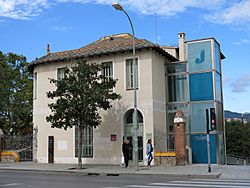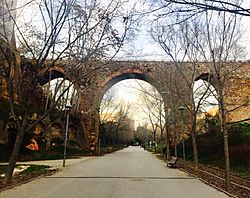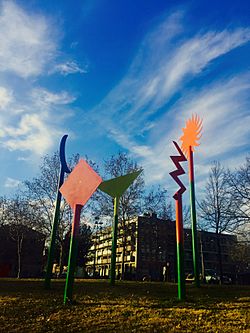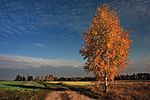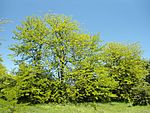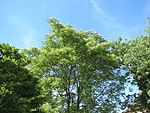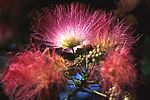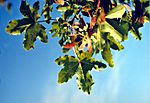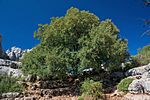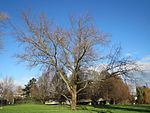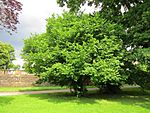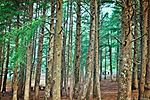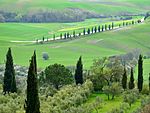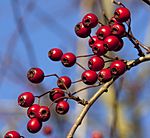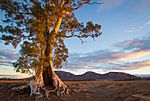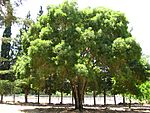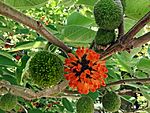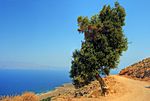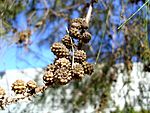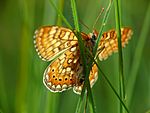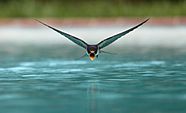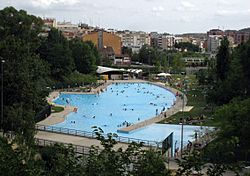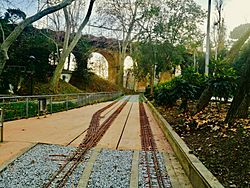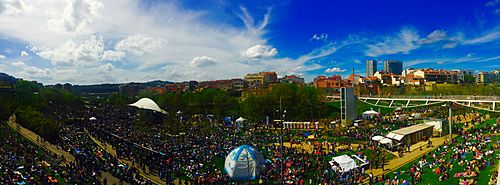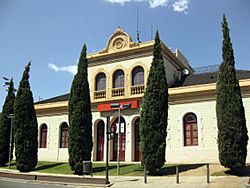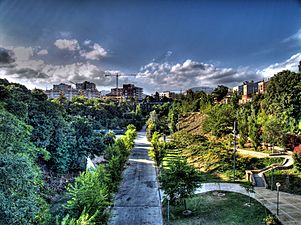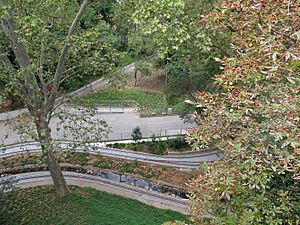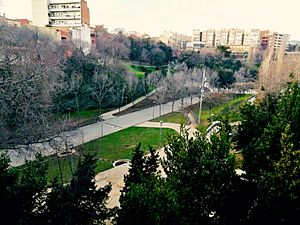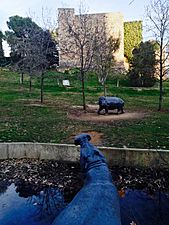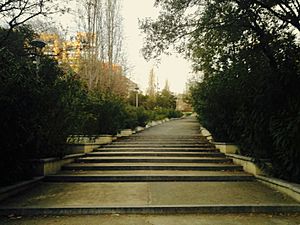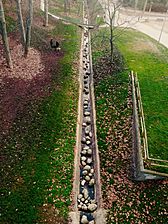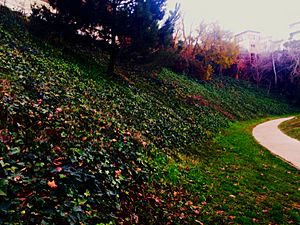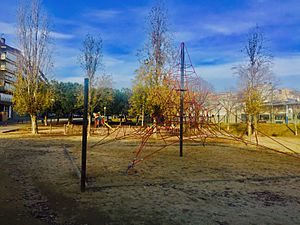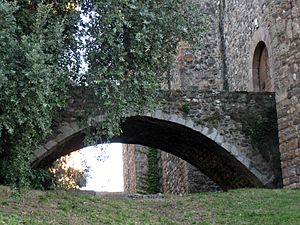Vallparadís Park facts for kids
Quick facts for kids Vallparadís Park |
|
|---|---|
| Parc de Vallparadís | |
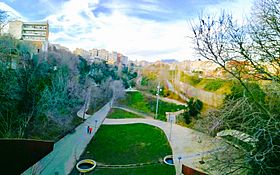 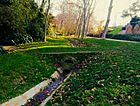 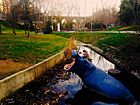
From left to right and from top to bottom: panoramic illustration of the park; submerged canal in the center of the park; hippopotamus sculpture with Puente de San Pedro in the background.
|
|
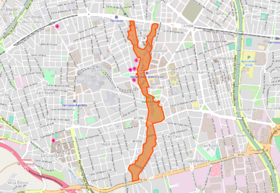
Location of the park in Terrassa
|
|
| Type | Public Park |
| Location | |
| Area | 39.5 ha (98 acres) |
| Operated by | City Council of Terrassa |
| Other information | Adjacent roads:
|
Vallparadís Park (officially Parc de Vallparadís in Catalan) is a large green space right in the middle of Terrassa, a city in Spain. It's like a long, green ribbon stretching about 3.5 kilometers (2.2 miles) from north to south, and it's usually about 100 meters (328 feet) wide.
Work on the park started in 1991, but people had been dreaming of a park here for a long time. The famous architect Manuel Ribas i Piera designed it. The Spanish government has even called the park a Bien de Interés Cultural, which means it's a very important cultural site.
This park is shaped like a "Y" because two streams, the Vallparadís torrent and the Monner torrent, meet inside it. These streams come together near the Monumental church complex of Sant Pere de Terrassa. This complex is a super old and important historical site with amazing Romanesque art.
Inside the park, you'll find cool places like the Textile Museum and Documentation Centre. This museum is one of the best places to learn about textiles, which are fabrics and clothes. There's also the Carthusian castle of Vallparadís, a castle from 1110! It's now the main part of the Terrassa city museum. Plus, there are other important buildings like the Casa Baumann and several bridges.
The park also has fun things to do, like a huge 180-meter-long swimming pool and a miniature train that goes through the middle of the park. Many exciting events happen here every year, too, like the Jazz Picnic and the Festival of Colors. Thousands of people come to enjoy these events!
Contents
What's the History of Vallparadís Park?
How the Land Was Formed
For millions of years, the Vallparadís and Monner streams have slowly shaped this area. Their water has carved out the land, making it part of the Catalan Coastal Depression, a natural dip in the land near the coast.
Scientists have found very old layers of earth here. These layers are made of sediments from the Neogene and Quaternary periods. These sediments come from different types of rocks, like metamorphic, volcanic, and plutonic rocks, as well as sedimentary rocks.
In 1997, archaeologists dug up over 26,000 fossils at a place called Cal Guardiola. About 3,000 of these were from mammals! They found bones of hippos, deer, horses, and hyenas. They also found parts of proboscideans (like elephants), bears, rhinoceroses, jaguars, macaques, and even a type of suidae (like a pig) that is a million years old! It's the only one of its kind found in Western Europe.
They also discovered very old plant remains, including two huge pieces of wood that were over 3 meters (10 feet) long.
How the Park Was Planned
People have lived in the "Vallis Paradisi" area since 1346. Farmers used to live along the streams in the park until the late 1800s. Then, Terrassa started to change a lot. The railroad arrived in 1856, and the city began to grow.
In 1895, the Puente del Paseo bridge was built. This was one of the first modern structures in the park area. Later, in 1915, the first big plan for developing the area as a park was made by Josep Maria Coll i Bacardí.
Over the years, more plans were created. In 1942, people asked for the Carthusian castle of Vallparadís to be protected as a historical monument. Finally, in 1972, a detailed plan for the park was approved.
In 1985, Manuel Ribas i Piera was chosen to design the park. His plan was built in three stages between 1991 and 1997. By 1999, the park was fully formed, and a master plan was made to guide how it would be managed.
What Buildings and Structures Are in the Park?
Monumental Church Complex of Sant Pere de Terrassa
The churches of Sant Pere de Terrassa are a group of very old Romanesque churches. They include Sant Pere, Sant Miquel, and Santa Maria. There's also an old clergy house and an archaeological site. These buildings were once part of an ancient city called Égara.
These buildings have been around for over 1500 years! They were fixed up in the late 1800s. In 1906, an architect named Josep Puig i Cadafalch explored the site. He found important clues about the history of the diocese of Egara, which existed from the year 400 to 750.
The complex is built on a small hill where the Vallparadís and Monner streams meet. It was built when Christianity became an official religion. First, a basilica was built, and later a cathedral. The church of Santa Maria and the clergy house are in this area today. They also built a special burial place with an underground crypt, which is now the church of Sant Miquel. Tombs from the 9th to 11th centuries have been found here. A parish church, now the church of Sant Pere, and an episcopal palace were also built.
This whole church complex grew bigger and bigger, reaching its most important time around the 11th and 12th centuries.
Textile Museum and Documentation Centre
The Textile Museum and Documentation Centre is a museum located on the east side of the park, next to the Carthusian castle of Vallparadís. It's all about the world of textiles, which means fabrics and clothing. Terrassa was a very important city for textile production during the Industrial Revolution.
The museum shows how different techniques and styles of textiles have been used throughout history. It has a collection of 365 fabric pieces that were added between 1946 and 1968. You can see old fabrics, brocade, and even church sarcophagi.
You can visit the museum to see its collection, or you can even look at some of its items online!
Carthusian Castle of Vallparadís
The Carthusian castle of Vallparadís is on the eastern side of the park. It was a fortification (a strong building for defense) that was first mentioned in records in 1110. That's when the land was bought from Ramón Berenguer III, who was the Count of Barcelona at the time.
The castle sits on the edge of a big slope in the park. It's shaped like a rectangle, with walls that have narrow openings for shooting arrows (called arrowslits). There are towers at each corner and three more towers on its west side. You can still see parts of the castle that were changed to make it a monastery. It has a two-story cloister (an open area surrounded by covered walkways) and special capitals on its columns. The old church of the monastery is now called El Tinellet.
Today, the castle is the main part of the Terrassa museum complex. It has different exhibits that show the natural environment of the Vallés area, prehistory, ancient times, the medieval world (with items from the Sant Pere churches and the castle itself), the modern era, and contemporary life.
Casa Baumann
Casa Baumann, also known as Casa Coll i Bacardí, is a building from 1913. It was designed by the architect Josep Maria Coll i Bacardí to be his own home. It's located inside the park, south of Vallparadís castle, near the Puente del Paseo.
The building originally had two floors and a large garden. It was later sold to a company called Ernest Baumann. In 1982, the City Council of Terrassa bought the property. The house was expanded in 1926 and again in 1951. In 1982, a fire damaged the upper part, and the city council had to fix it. In 1995, the outside of the building was repaired. Finally, in 2007, the entrances were made easier to use, parts of the inside were changed, and the elevator you see on the outside today was installed.
In 2003, Casa Baumann was declared a Bien Cultural de Interés Local, which means it's an important local cultural site. Today, it's used as the headquarters for the Youth and Children's Leisure Service of the City Council of Terrassa.
Retaining Walls at Casa Salvans
The retaining walls of the Casa Salvans were designed by Lluís Muncunill i Parellada. They are located on Salmerón Street, right next to the park. These walls are made of rubble stone (rough, broken stones) that get smaller as the wall goes higher. They are built with pebble stones that form an uneven line, going down a slope towards the Monner de Vallparadís stream. At the highest part, there's a part that sticks out, used as a lookout point.
In 2003, these walls were also declared a Bien Cultural de Interés Local by the Generalitat de Catalunya, the government of Catalonia.
Bridges in the Park
Vallparadís Park is like a valley, with an average slope of 10 meters (33 feet). Because of this, many bridges and footbridges cross the park, connecting its two sides.
On the western side of the park's "Y" shape is the Puente de San Pedro (Saint Peter's Bridge). This bridge was built in 1579 by the people of San Pedro. It connects the Centro and Antiguo Pueblo de San Pedro neighborhoods. The bridge is 19.30 meters (63 feet) high, 57 meters (187 feet) long, and 3.50 meters (11.5 feet) wide. You can use it to reach the churches of Sant Pere. It has three arches of different sizes. The middle arch is round, and the side ones have pointed arches. It's mostly made of brick, except for the corners, which use cut stone. Since 2006, cars are not allowed on it, only people walking. This bridge is also considered a Bien Cultural de Interés Local.
Further south, where the two streams have joined, is the longest bridge in the park: the Puente del Paseo (Promenade Bridge). This bridge connects the Vallparadís and Cementerio Viejo neighborhoods. It was built in 1895 to help traffic flow out of northern Terrassa. It's 112 meters (367 feet) long and 16.13 meters (53 feet) high. It has six arches supported by strong pillars. The underside is made of brick. It has four lanes for vehicles and sidewalks on both sides. The bridge was made longer in 1960 and 1990. It's also protected as a Bien Cultural de Interés Local.
Between the Monner stream and 22 de julio avenue, there's the footbridge of the torrent of Las Brujas (Witches' Stream). This footbridge connects San Valentín street with Buenaventura Castellet street. It opened on March 13, 1999.
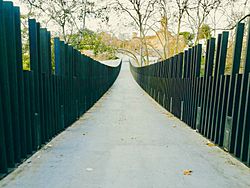
The Monner torrent footbridge, also called the San Pedro footbridge, was first planned in 1915. It was finally opened in 2004. This bridge is 80 meters (262 feet) long and has no pillars, supported by two cables. It's considered a unique engineering work in Europe and has won many awards!
Going south, before you reach the Vallparadís swimming pool, you'll find the bridge of the Cementerio Viejo (Old Cemetery). In 1830, an old cemetery became the official cemetery of Terrassa. A road used to go through the Vallparadís stream to reach it. After the Puente del Paseo was built in 1896, this old road was removed. After the big floods of Vallés in 1962, a lake formed in this area. In 1967, a footbridge was built, known as the Puente del Cementerio Viejo.
Past the Vallparadís swimming pool, heading south, is the Fuente de Serracanta walkway. This footbridge opened on April 28, 2007. It connects Escudé street with Hermano Joaquín street. The bridge is 101 meters (331 feet) long, 3 meters (10 feet) wide, and weighs 46 tons. It's made of steel and supported by two pillars. It even has an elevator to connect the park with the footbridge!
Finally, near the very south end of the park, is the Puente de la Unión (Union Bridge). This footbridge opened on February 19, 2010. It connects the Can Palet neighborhood with the 20th century neighborhood. It's 107 meters (351 feet) long. Its name was chosen by students from local schools.
What Sculptures Can You Find?
You can find several sculptures scattered throughout Vallparadís Park.
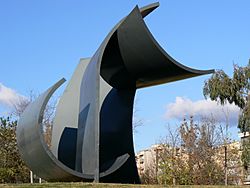
At the very north end of the park, there's a sculpture called "Homage to Malevich" (Homenatge a Malèvitx in Catalan). It's dedicated to Kazimir Malevich, a Russian painter. This artwork was created by Jorge Oteiza and was first shown on May 15, 1999. It's a huge piece, weighing 26 tons, and it's made of special steel. It represents a "spatial rotation" idea that Malevich had.
In the eastern part of the park's northern end, you'll find "La sardana." This monument is a tribute to the sardana, a traditional Catalan dance where people dance in a circle. It was made by the Escola d'Arts i Oficis de Barcelona (Municipal School of Arts and Crafts of Barcelona). It was unveiled in 1998 during a celebration where Terrassa was named the "pubilla" (a special honor) of Catalonia.
In the northern part of the park, near the 22 de julio walkway, there's a sculpture from 1999 called "Relaciones del espacio" (Relationships of Space). It was made by Àngel Màdico. This sculpture has five colorful parts that look different depending on where you stand. It has poles over three meters tall with shapes like the moon, sun, lightning bolt, a triangle, and a rhombus in blue, yellow, red, green, and pink. The artist wanted to mix nature and abstract shapes, letting you create your own view by moving around. This naïve style sculpture is a favorite among park visitors.
In 2001, a "Monumento a las víctimas del terrorismo" (Monument to the victims of terrorism) was approved for the park. It's 3 meters (10 feet) tall and was made by Jesús Fructuoso. It's a stone block with a bronze window. You can find it on the main path of the park, near the swimming pool entrance. The monument was suggested by groups like Terrassa per la Pau and the Asociación de Víctimas del Terrorismo. It was opened on March 23, 2002, and the artist said it represents "a door to freedom, to a future and to peace."
What Plants and Animals Live in the Park?
Even though Vallparadís is a city park, it's like a green lung for Terrassa. It has many different plants and trees. The animals here are mostly insects, birds, and small creatures.
Flora: The Plants of Vallparadís Park
This park is one of the biggest in Catalonia and has a huge variety of plants and trees. The most common trees are stone pines (29.2%), plane trees (22.75%), and holm oaks (29.2%). You can also find false acacias, Mediterranean cypresses, olive trees, and ash trees. Other trees include poplars, blue gum trees, laurels, tulip trees, cherry plum trees, maples, and hackberry trees.
For smaller plants, you might see honeysuckles, common ivy, purple morning glory, common barberries, rosemary, mock oranges, or abelias.
Here's a table showing some of the plants in the park:
| Name | Location | Origin | Features | Photograph |
|---|---|---|---|---|
| Birch | Monner torrent | Europe, East Asia and North Africa | White bark tree with small greenish flowers. The fruit is very small and the leaves are triangular in shape. | |
| Honey locust | Fuente de Sagrera torrent and Parque del Norte | North America | Deciduous tree up to 25 m tall with serrated green leaves with 20 or more leaflets and flowers with radiate symmetry. | |
| Tree of heaven | Under the Puente de San Pedro and at the Fuente de la Puput. | China | Deciduous tree, 20 m tall, with smooth, whitish bark, compound leaves and broad, lobed, triangular leaflets. The flowers are small and greenish. | |
| Persian silk tree | Las Brujas and Fuente de Sagrera torrents | Iran, Taiwan and China | It reaches up to 6 m in height. The leaves contain small, asymmetrical leaflets. Fruit up to 20 cm long. | |
| Judas tree | Las Almas torrent path to Moncada road. | Southern Europe and Asia | Small deciduous tree with dark brown rough bark and ocrazon-shaped leaves. Flowers with unequal petals, appear in April or May. | 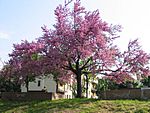 |
| Field maple | Fuente de Sagrera torrent. | Sierra del Obac | Leaves divided into five lobes, 4 to 7 cm long. The fruit has two wings open at an angle of 180 degrees. | |
| Montpellier maple | Fuente de Sagrera torrent. | Australia | Tree up to 15 m tall, with simple greenish leaves with three lobes. Wings of the fruit arranged at an acute angle. | |
| Norway maple | Monner torrent. | Eurasia | Tree up to 30 m high, with simple leaves of 10 to 15 cm with five to seven lobes and yellowish green flowers. | 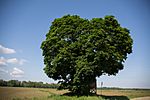 |
| Silver maple | Huertos de los Frailes, in the Fuente de Sagrera torrent and Las Almas torrent. | Eastern North America | Tree over 35 m tall and leaves with five toothed lobes. Greenish flowers in hanging clusters. | |
| Common hazel | Las Brujas torrent. | Mediterranean Basin | Native shrub up to 6 m high and deciduous leaves. Brown fruits and flowers grouped in very dense inflorescences. | |
| Red horse-chestnut | Wall of the Casa Salvans, under the Casa Baumann. | Greece, Albania and Bulgaria | Deciduous tree over 20 m tall with leaves between five and seven toothed leaflets, white flowers. | 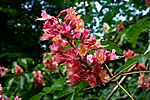 |
| Atlas cedar | Behind La Muntanyeta restaurant. | Lebanon, Syria and Turkey | Tree that can reach 40 m in height with grayish fissured bark and primary ramifications, frequently horizontal. | |
| Mediterranean cypress | All over the park. | Greece, Iran and Turkey | Evergreen tree up to 30 m tall with dark, thin and superficially wrinkled bark. Green leaves arranged in four opposite rows of two by two. | |
| Common hawthorn | Fuente de Sagrera torrent. | Europe, North Africa and Asia | Small deciduous tree with small leaves with three to seven lobes and white flowers. The fruits are bright red. | |
| River red gum | Muntanyeta slope and Parque del Norte | Australia | Tree up to 40 m tall with straight and cylindrical trunk and greenish brown bark. Elongated leaves with aromatic glands and isolated white or red flowers. | |
| Sycamore | Fuente de Sagrera torrent. | Central and Northern Europe | Deciduous tree that can reach 30 m in height, with smooth bark. Simple and toothed leaves with three to five lobes. | 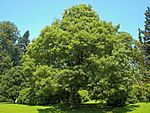 |
| Narrow-leaved ash | Fuente de Sagrera torrent and Parque del Norte | Southeast Asia, Southern Europe and Northeastern Africa. | Deciduous tree up to 20 m high with opposite leaves with up to thirteen leaflets and fruits gathered in clusters. | |
| European beech | Monner torrent, next to the San Pedro footbridge. | Europe | Deciduous tree up to 30 m tall with smooth grayish bark and oval or elliptical translucent leaves and flowers that bear between two and three fruits. | 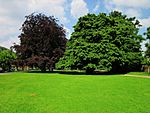 |
| European nettle tree | Monner torrent and Rector Oms square viewpoint. | Mediterranean Basin | Deciduous tree with elongated leaves and rough to the touch with three main nerves at its base. Solitary axillary flowers and edible fruit. | |
| Strawberry tree | Las Brujas torrent and Puente del Cementerio Viejo. | Mediterranean basin and southwest Ireland | With thick leaves, the fruit is a rough edible berry that ripens after a year when the tree is in flower again. | 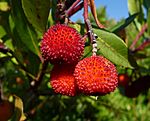 |
| Mimosa | Las Almas torrent, next to the park office. | Australia | Petiolate leaves without stipules, bluish-green and more than 10 cm long. |  |
| Paper mulberry | Talud de la Mutua, near the mini-train circuit. | Japan, Malaysia, China and Taiwán | Deciduous tree up to 12 m high with smooth bark and leaves 7 to 20 cm long. | |
| Olive | Throughout the park, in greater numbers in the Las Almas torrent. | Mediterranean Basin | Tree with grayish green leaves on one side and whitish on the other. Its fruit, the olive, blooms in late spring and early summer. | |
| Italian maple | Fuente de Sagrera torrent. | North Africa and Iberian Peninsula | Tree up to 15 m high, with simple leaves with five lobes and few flowers, these are greenish or yellowish. | 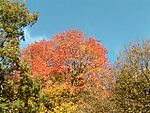 |
| River oak | Las Almas torrent, in front of the park office. | Polynesia, Malaysia and Australia | Evergreen tree up to 20 m, straight trunk and wide bark. The leaves are not visible to the naked eye and the fruits are similar to conifer cones. | |
| Tulip tree | Fuente de Sagrera torrent. | North America | Tree reaching 40 m with a pyramidal form. Flowers are yellow and fruit are brown. | 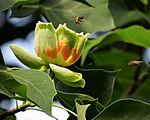 |
Fauna: What Animals Live in the Park?
Since Vallparadís is a city park, the animals you'll find are mostly those common in urban areas. This includes small mammals like different types of bats and shrews. You'll also see common city animals like mice and cats.
For invertebrates (animals without backbones), you might spot beetles like acilius sulcatus or stictonectes lepidus. There are also lepidoptera (butterflies and moths) like the Marsh fritillary or the amazing Spanish moon moth. And don't forget the gastropods, which are different kinds of snails.
The most common animals in the park are birds. You'll see typical city birds like the house sparrow, rock dove, great tit, magpie, serin, and blackbird. Because Terrassa is close to the Sierra del Obac mountains, you might also see birds of prey like the short-toed snake eagle, Eurasian sparrowhawk, and Eurasian hobby. At night, you could spot owls like the Eurasian scops owl, barn owl, or Long-eared owl.
Smaller birds you might observe include the crested tit, blue rock thrush, song thrush, sandpiper, or common firecrest. At certain times of the year, you can even see migratory birds passing through, such as the black redstart, white wagtail, European golden oriole, or common house martin.
What Facilities Does the Park Offer?
Vallparadís Park has many facilities beyond just a normal city park. These offer extra services for visitors. You'll find a 180-meter-long swimming pool, a large miniature train, a healthy playground, children's play areas, restaurants, and easy access for people with reduced mobility, even though the park has different levels.
The Municipal Swimming Pool
In the southern center of the park, between the Puente del Cementerio Viejo and the Moncada road, is the municipal swimming pool. It's also called Vallparadís lake. It opens at the start of summer, usually around Saint John's Eve when the school year ends. The pool stays open until September and offers many activities, especially for younger visitors.
The pool is 180 meters (590 feet) long and covers about 5000 square meters (53,820 square feet). Since June 2014, the Club Natació Terrassa has managed the pool.
The Miniature Train
In the middle of the park, there's a large, outdoor miniature train. It's called manned model railroading or live steam. The track is 340 meters (1,115 feet) long and has a track gauge of 127 and 184 mm. It includes eleven switches, two bridges (one that rotates!), two tunnels, a traffic circle, a locomotive garage, and a workshop. It even has a real switch lever from a station in Barcelona!
The train was first shown on February 18, 1995, by Jordi Pujol, who was the President of Catalonia then, and Manuel Royes, the Mayor of Terrassa. The train officially opened on June 29, 1996. Since then, a special "International Meeting of Vaporistas" (steam train enthusiasts) has been held here.
Since 1996, from October to June, the Vallparadís Railway has allowed students and teachers to visit. They learn about the history and how the miniature train works. They also learn about its energy sources, like electricity, batteries, and coal, and how electric and steam locomotives operate. As of April 2017, about 14,000 people have taken these educational visits!
What Events Happen in the Park?
Since Vallparadís is a big green space in a major city like Terrassa, it's used for many events and outdoor activities. Some of the most popular ones, which attract thousands of people, are the Picnic Jazz, the Holi festival (or festival of colors), the burial of the carnival, and the children's festival during the city's main celebrations.
Picnic Jazz
The Pícnic Jazz has been held in the park since 1982. It's part of the Terrassa Jazz Festival and brings in thousands of people every year, usually in March or April. The event features many musicians, from famous international artists to new, rising stars. Over the years, about 3500 musicians have performed in more than 800 concerts! There are also exhibitions, movie showings, talks, and tributes. Famous musicians like Stan Getz, Chet Baker, Dizzy Gillespie, and Ray Brown have played here. During the event, you can find services like a record fair, places to buy merchandising, restaurants, and free bicycle parking.
Holi Festival
In May, the Holi festival, or festival of colors, is celebrated in the park. This party comes from Hindu traditions and celebrates the arrival of spring. People throw huge amounts of colored pigment powders into the air. When the powders fall, everyone gets covered in different colors! In Hindu tradition, this event is a time to let go of past mistakes, forgive, and reconnect with people. Thousands of people attend this event every year.
Burial of the Carnival
The burial of the carnival (enterrament del carnestoltes in Catalan) is the final event of Terrassa's carnival festivities. It happens every year in Vallparadís Park on Ash Wednesday. The event is a funeral procession that shows a playful fight between characters like His Majesty Carnival and Lent. The burial ends with a bonfire to burn the carnival, skeleton dances, and the ghost of death. Volunteers dress up in black costumes, and the procession starts from City Hall and goes to the park. More than twenty cultural groups and about 400 volunteers take part.
Children's Major Festival
Every year, for three days in early July, during Terrassa's main city festival, the children's major festival takes place in Vallparadís Park. It's dedicated to kids and offers all kinds of performances like theater, circus, storytelling, animation, magic shows, and workshops. Many entertainment companies participate. On the last day, there's a special "gran festa del dilluns" (great Monday party) where hot chocolate is given out, stories are told, there's a water festival, and a concert for children.
How to Get to the Park
Vallparadís Park runs through the center of Terrassa from north to south, so it has many ways to get in.
By Train
At the north end of the park, on the west side (near the Monner stream), is the Terrassa station, also called North station. It has train services operated by Renfe and is part of the R4 line of the Cercanias Barcelona network. The station building, built in 1901, is listed as a Bien Cultural de Interés Local by the Government of Catalonia.
In the center of the park, you'll find the Vallparadís Universitat station. This is an extension of the Barcelona-Vallés line of the Ferrocarriles de la Generalidad de Cataluña (Catalan government railways).
By Bus
Many bus lines cross the park on its bridges and roads. The northern part of the park is served by Lines H (which crosses the park) and 2 (which connects the Rambla station with the East station). Lines 4 and 7 (which runs parallel to the park) cross the center of the park. Lines 8, 9, and 10 also go through parts of the park.
By Car
Three of the city's main avenues cross Vallparadís Park by road or bridge:
- At its northern end, where the North Station is, the park starts at 22 de Julio Avenue. This road connects Terrassa from east to west.
- Jacquard Avenue crosses over the center of the park using the Puente del Paseo. This road connects the university area (where the Terrassa Engineering School and Vallparadís Universitat station are) with the city's main business center.
- In the southern area, Santa Eulalia Avenue crosses the park using the Puente del Cementerio Viejo. This avenue is also known as the N-150, which connects the C-16 highway (west of Terrassa) with the C-17 highway in Montcada i Reixac.
If you're coming from outside the city, the easiest way to get to the park is to take the Terrassa center exit from the C-58 highway. Then, turn right at the first traffic circle onto Montcada road, which will lead you to the south-central part of the park.
Multimedia gallery
See also
 In Spanish: Parque de Vallparadís para niños
In Spanish: Parque de Vallparadís para niños


